At work last week I heard someone talking about wishing they, “could get away for some winter sun”. Sometimes I find people hard to understand. Winter is my favourite time of year and the thought of missing it for some ‘winter sun’ seems absurd to me.
The Nature Trail is quieter in the colder months. My favourite time to go is immediately after heavy rain, before most people have got out and about again. Then you can have the place to yourself and can peer undisturbed into the undergrowth.
In spring, there is sometimes almost too much to see. You don’t know whether to chase the butterfly, watch the hoverfly, or try to identify the grass.
Winter wildlife is sparse, but special. At this time of year the more discreet living things come into their own. Mosses, lichen and fungi are more visible, and are fresher in the damp air. The robin’s thin, fragile winter song and the rustling of squirrels in the trees provides a perfect soundtrack for your walk.
The other day we were lucky enough to find a splendid example of a slime mould, a greyish white mass spreading over the damp brown undergrowth and climbing over twigs and dead leaves.
This particular slime mould is called the Dog’s Sick Slime Mould (Mucilago crustacea). With slime moulds it is better to use the Latin names, as the common names often overlap. There seem to be several slime moulds called Dog’s Sick or Dog’s Vomit, which, let’s be honest, are not very flattering names for such a special organism.
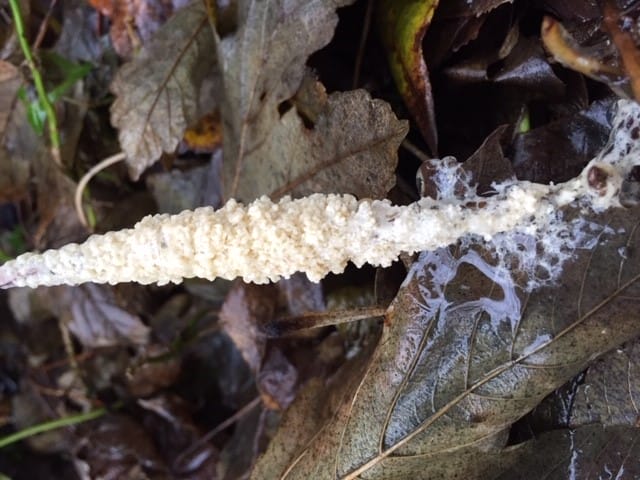
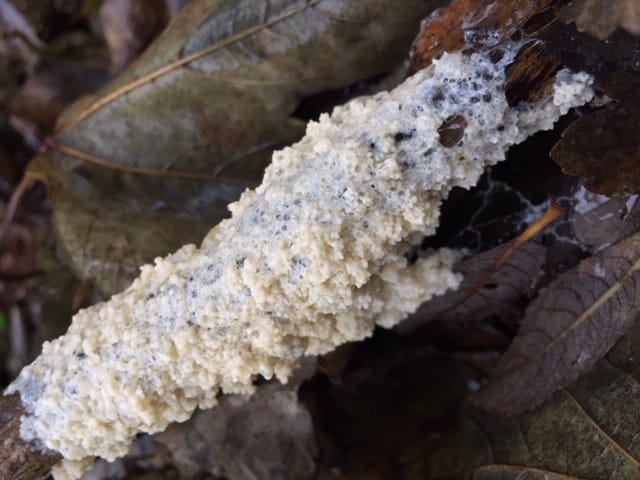
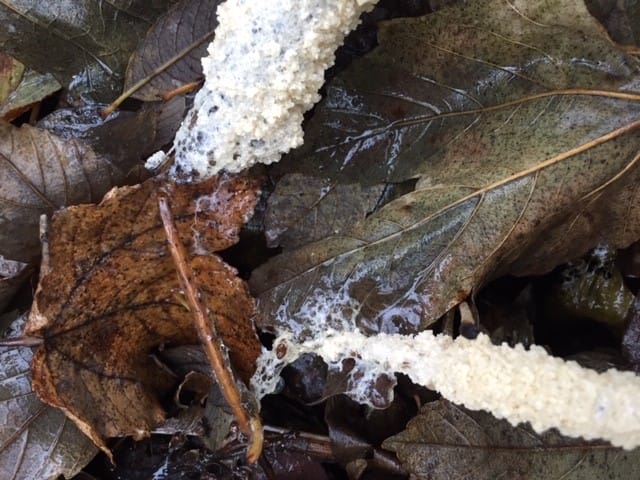
Admittedly it is the sort of thing one might well walk past, looking as it does like a pile of porridge. But it is not porridge, nor vomit, nor an algae or fungus. Slime moulds do not belong to the animal plant or fungal kingdoms. They sit in the kingdom Protista, and are protozoa, not unlike the amoeba we learn about at school.
For part of their life slime mould amoeba live independently as single-celled organisms in the soil (which are far too small to see unless you use a microscope).
But when their food (bacteria found in rotting wood and dead plants) is in short supply, or when they want to reproduce, the little organisms mass together in a great slimy pile. They communicate and co-ordinate their movements by producing chemicals, which change the behaviour of each protozoa by stimulating receptors on their cell membrane – just like the nerve cells in our brain and spinal cord.
There are two types of slime moulds: cellular types, which maintain their individual integrity even when grouped together, and the so-called acellular types, which actually lose their cell walls and form what is effectively a single giant amoeba with lots of nuclei in a big slimy bag. The technical term for this giant blob is a plasmodium.
This plasmodium acts very much like a single organism, spreading its ‘tentacles’ around to find food. It is this type, in particular one called Physarum polycephalum, which is often studied in laboratories. It has been found to be able to navigate its way around mazes to find food, and form networks linking food sources analogous to how humans build roads and railway networks to connect towns and cities.
Mucilago crustacea is also one of these acellular slime moulds, and forms one of the largest plasmodia in the UK.
To get a feel for how these organisms work watch some beautiful time-lapse videos of slime moulds doing their thing on YouTube – for example:
Slime mould plasmodia are an excellent example of communal intelligence, where a brainless single celled organism can exhibit sophisticated behaviour by grouping together, communicating, and changing behaviour in response to environmental conditions. In some senses the plasmodium is not that different from our brain. After all our brain, like a slime mould plasmodium, is a mass of interconnected cells which communicate with each other by chemicals.
Humans think we are far cleverer than slime moulds, but are we? The individual slime moulds, at times of stress, work together to find food and survive. What do humans do at times of stress? I will leave each reader to ponder that for themselves…
If that isn’t profound enough for you, the structure of slime mould ‘societies’ has also been thought to mimic the structure of the universe itself. Their networks are analogous to the galaxy filament structure of the universe, with its walls of gravitationally bound superclusters of billions of galaxies. I am getting way out of my depth now so here is an article all about this amazing research.
There is quote I read somewhere along the lines of, “look up at the stars and you will see yourself” referring to how the galaxy networks are connected like neurons in the human brain. You could equally well say, “Look down at the Dog Sick Slime Mould and you will see not only yourself but the universe as well.”
Here is another slime mould I found on the Nature Trail. This one looks like a pinkish blob of bubblegum sitting on a tree stump or log, often in little clusters. These blobs are the fruiting bodies of the Wolf’s Milk Slime Mould (Lycogala epidendrum) which become brown and mature and then release their spores to start a whole new generation of slime moulds.
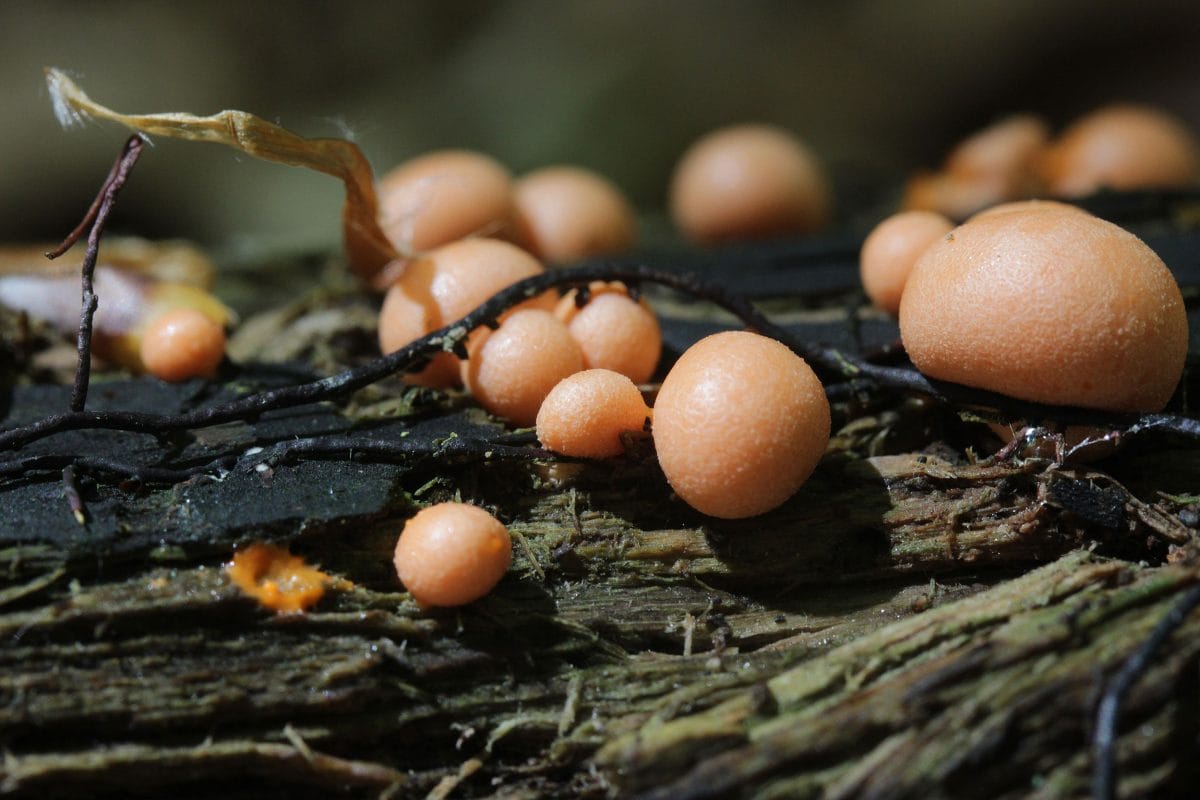
Lastly, I couldn’t resist showing you this fungi – a Silver Leaf fungus (Chondrostereum purpureum) found on a pile of logs. I love its colour.
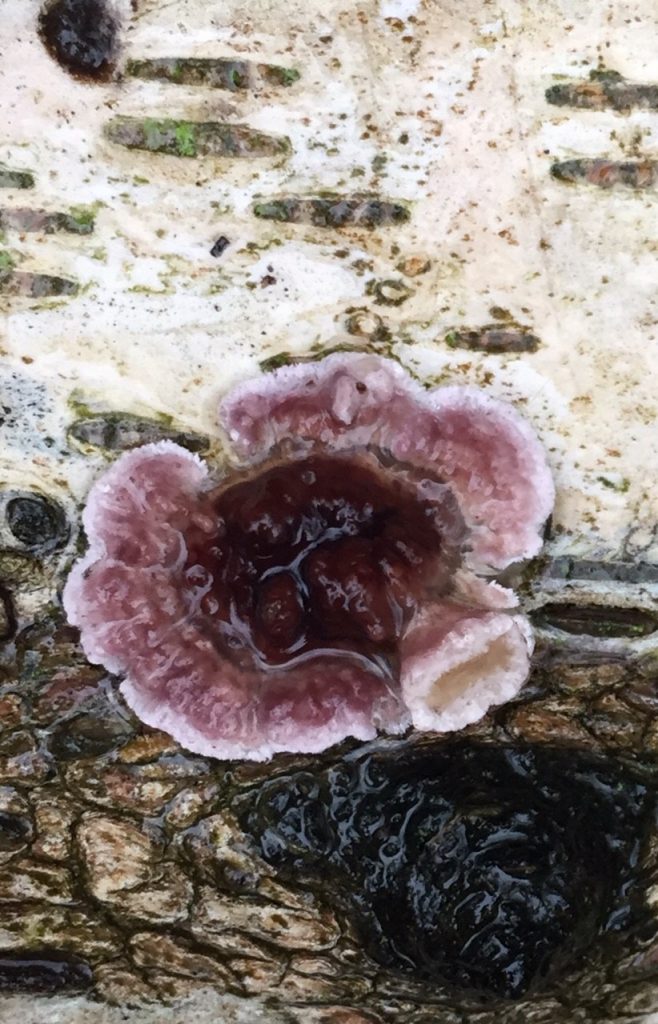
Silver leaf fungus, Daniel Harwood
So who says winter in Britain is boring? It certainly isn’t on the Horniman Nature Trail.
If you want to learn to identify slime moulds the excellent Naturespot website has some useful photographs and ID tips.
There is a Facebook group called British Slime Moulds whose members are very supportive of beginners and which hosts some beautiful photos.


